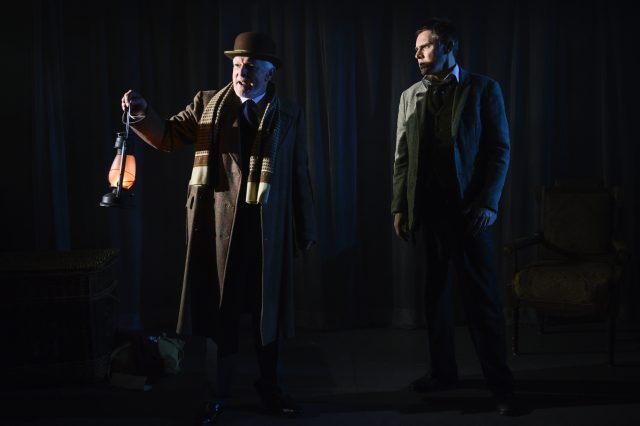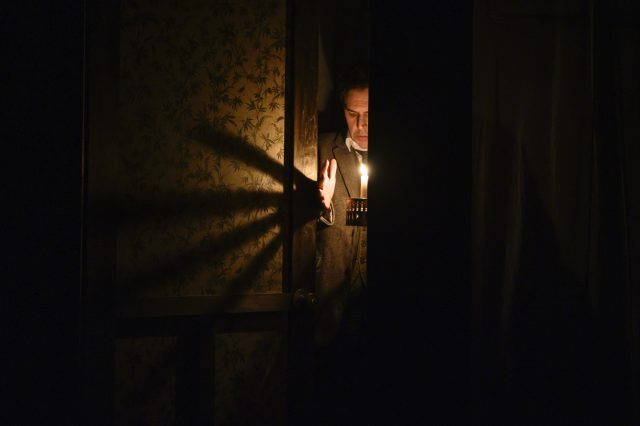
David Acton and Ben Porter reprise their London roles in New York debut of The Woman in Black (photo by Jenny Anderson)
The McKittrick Hotel
530 West 27th St. between Tenth & Eleventh Aves.
Wednesday – Monday through April 19, $85
mckittrickhotel.com
A few months ago, I finally gave in and saw The Perfect Crime, the mystery that’s been running in Manhattan since 1987 and features Catherine Russell; having racked up more than thirteen thousand performances in the same role, she’s now in the Guinness Book of World Records. Yet there was nothing special about it that made me understand its longevity. So it was with both trepidation and curiosity that I went to the New York premiere of The Woman in Black, which has been playing in London’s West End continuously since 1989. The two-act, 130-minute show is being staged in the McKittrick Hotel’s Club Car, the previous home of the National Theatre of Scotland’s fun, immersive drama The Strange Undoing of Prudencia Hart, among other presentations.
Adapted by Stephen Mallatratt from Susan Hill’s Gothic novel and directed by Robin Herford, The Woman in Black gets off to a slow start, establishing a play-within-a-play format that could use a jump to get things going. A finicky old man named Arthur Kipps (David Acton) has hired an actor (Ben Porter) to punch up a ghost story he has written, based on events that happened to him. “I recalled that the way to banish an old ghost that continues its hauntings is to exorcise it,” Kipps says. “Well, then. Mine should be exorcised. I should tell my tale. I should set it down on paper, with every care and in every detail. I would write my own ghost story, and then, that my family might know and that I might be forever purged of it, relive it through the telling. The first part, the writing, I have done. Now comes the telling. I pray for God’s protection on us all.”

Mr Kipps (Ben Porter) wonders what’s behind the locked door in Gothic drama at the McKittrick Hotel (photo by Jenny Anderson)
The first act introduces the audience to the setup: The old man has no sense of drama and repeatedly proclaims that he is not a performer, which is why he needs the Actor. (As in the script, Porter will heretofore be called Kipps, and Acton will be Actor.) In reciting the tale, the actor takes on the persona of Kipps as a young man, while Kipps juggles all the other roles, including a lawyer, a dapper gentleman with a dog, a landlord, a legal agent, and a carriage driver. Michael Holt’s set is spare, with a chair, a large wicker basket, and a curtain in the back that later reveals covered furniture behind it. Anshuman Bhatia’s lighting and Sebastian Frost’s sound play key parts in giving the show a bigger feel. Guests sit in chairs lined up in long rows; the bar features such cocktails as Woman in Black Punch, the Old McKittrick, and Mr Kipps. You can also have “Pie & a Pint”: a beer and a pub platter, pie & mash, or duck shepherd’s pie. A full dinner is available before the show.
The story that Kipps wants the Actor to tell is about himself as a young lawyer, as he travels to the end of nowhere, Eel Marsh House, for the funeral of a longtime client of his firm, the very much not-beloved Mrs Alice Drablow; in addition, he is to go through her papers to make sure her accounts are in order. As Kipps and the Actor play out the scenes, the latter often interrupts, concerned about how certain elements will be brought to life onstage. “There are so many things we cannot represent. How do we represent the dog, the sea, the causeway? How the pony and trap?” he asks. Kipps responds, “With imagination, Mr Kipps. Ours, and our audience’s.” He also notes that the unseen Mr Bunce will be using sound effects to further enhance the telling. The closer Kipps gets to Eel Marsh House, the creepier people act when they learn where he is going. And beware the Woman in Black, who’s liable to make you jump out of your skin.
The first act’s meta-discussion of stagecraft is repetitive and stodgy, but the show finally finds its groove in the second act, once Kipps arrives at his destination and dives into his research — and wonders what’s behind the locked door. After a bumpy beginning, the Actor settles into his responsibilities portraying numerous characters quite well while experiencing those long-gone days all over again. “I have a horror of it,” he tells Kipps. “Watching you, it is as if I relive it all, moment by moment . . . though you, of course, will never suffer as I did — I must always tell myself that.” Such is the nature of theater, which merely attempts to re-create and capture a sense of reality. There are plenty of scares as the denouement approaches; we were fortunate to have a screamer next to us, which was a bonus. Acton and Porter, who have performed the play in the West End, have an amiable camaraderie; Herford likes to keep things fresh, so he changes the cast in London every nine months (which is a far cry from the situation in The Perfect Crime). The Woman in Black is scheduled to run through March 8, but shows have a habit of extending at the McKittrick; Sleep No More has been playing there since 2011. [Ed. note: The Woman in Black has now been extended through April 19.] Of course, it looks like nothing will ever top The Mousetrap, the Agatha Christie show that has been running in the West End since 1952. Perhaps most important, The Woman in Black feels right at home in the Club Car, providing plenty of chills and thrills once the exposition gets out of the way.